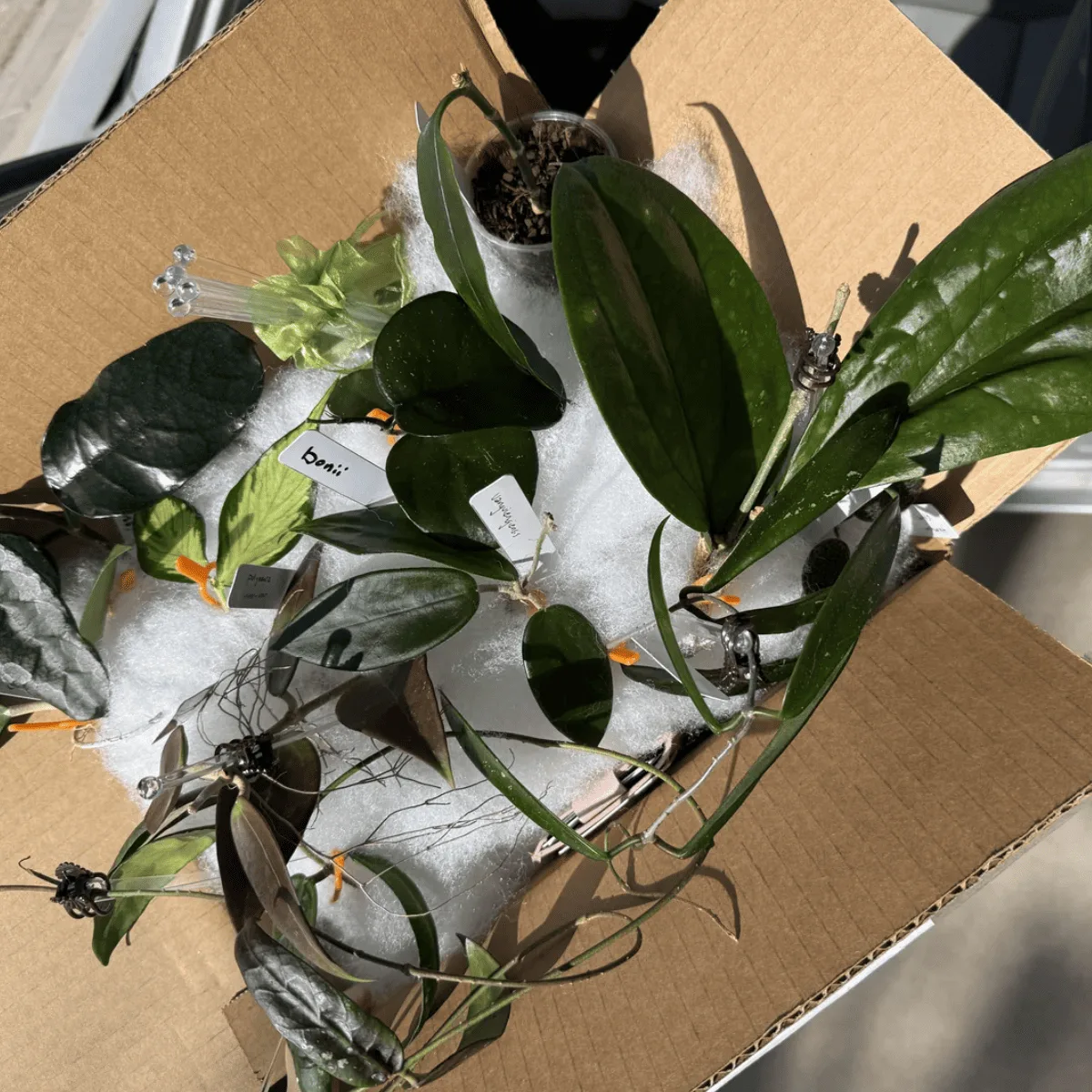Ever shipped a Hoya plant only to have it show up looking like it just survived a wrestling match with the mail truck? Yeah, I’ve been there too. The first time I mailed a Hoya carnosa to a friend, I thought bubble wrap and good vibes would do the trick—spoiler alert: it arrived with more snapped vines than a horror movie set. Hoyas are gorgeous, tough little tropical gems, but shipping them? That’s a whole different ballgame.
If you’re staring at your prized wax plant, wondering how to get it across the state—or even the country—without turning it into compost, you’re in the right place. I’ve spent years growing and shipping these beauties, learning the hard way so you don’t have to. This guide is packed with my best Hoya plant shipping tips practical, tested, and straight from the heart of someone who’s obsessed with keeping these plants happy. We’ll cover prep, packing, shipping tricks, and even what to tell the lucky recipient. Let’s make sure your Hoya’s next adventure ends with a standing ovation, not a sad droop.
Why Hoyas Are Shipping Drama Queens (and How to Handle It)
Picture this: Hoyas are chilling in the wild, soaking up humid jungle air, basking in dappled light. Then we stuff them in a dark, dry box and expect them to love it. No wonder they throw tantrums! Their thick, waxy leaves and sprawling vines make them prone to drying out, snapping, or just plain sulking if the temp dips too low or spikes too high. But don’t worry—I’ve got your back. With a little care, you can turn that bumpy ride into a smooth trip.
Hoya Plant Shipping Tip #1: Prep Like a Plant Whisperer
Before you even think about tape and boxes, your Hoya needs some pre-travel pampering. Here’s how to set it up for success:
- Water Just Right: Give it a thorough drink 1-2 days before shipping—moist soil, not a swamp. Too wet, and you’ll have a moldy mess; too dry, and it’ll arrive gasping. For succulenty types like Hoya kerrii, err on the drier side—they’ve got water stashed in those chunky leaves.
- Trim the Excess: Snip off dead leaves or anything looking rough. Long vines? Gently tie them with twine or a soft hair tie to keep them contained. I once shipped a Hoya pubicalyx without tying it up—big mistake. It looked like a bad hair day by the time it arrived.
- Toughen It Up: If you’ve got a few days, move it to a shadier, cooler spot. It’s like a mini boot camp to prep it for the dim, chilly shipping life.
Heads-Up: Got blooms or a fresh repot? Hold off on shipping. Your Hoya’s already stressed—don’t pile on a road trip.
Hoya Plant Shipping Tip #2: Pack It Like You Mean It
Packing is where you channel your inner Tetris master. A sloppy job means a sad plant, so let’s get this right.
Box It Smart
- Grab a sturdy corrugated cardboard box—think “could survive a toddler tantrum” sturdy. It should fit the plant snugly with a couple extra inches for padding. Too big, and it’ll bounce around; too small, and you’re crushing its vibe.
Cushion Everything
- Pot TLC: Wrap the pot in bubble wrap or foam—plastic pots are lighter and less breakable than clay. Secure it with tape so soil doesn’t spill everywhere. (I’ve got a “soil explosion” story I’ll spare you.)
- Vine Armor: Wrap those delicate stems in tissue paper or soft fabric. For extra-long ones, slide them into cut straws or cardboard tubes—sounds weird, works like a charm.
- Fill ‘Er Up: Pack the gaps with packing peanuts, crumpled newspaper, or air pillows. The goal? Zero wiggle room without squishing the plant.
Humidity Hacks
- Hoyas hate dry air. Tuck a damp (not sopping) paper towel or a pinch of moist sphagnum moss near the roots. Want to go pro? Wrap the foliage in a perforated plastic bag—like a little travel spa.
Weatherproof It
- Winter Woes: Add a 72-hour heat pack (UniHeat’s a fave) away from the plant—too close, and it’s a sauna disaster. Insulate with bubble wrap inside the box.
- Summer Sizzle: Slip in a small ice pack wrapped in cloth, positioned to cool the air, not freeze the roots. Check the forecast—skip shipping during heatwaves or blizzards.
Label Love: Slap on “Fragile,” “Live Plants,” and “This Side Up” in big, bold letters. Waterproof marker’s your friend here.

Hoya Plant Shipping Tip #3: Speed Is Your Superpower
The longer your Hoya’s in transit, the crankier it gets. Fast shipping is non-negotiable.
- Pick the Quick Stuff: USPS Priority Mail (1-3 days) is my go-to—cheap and solid. UPS 2nd Day Air or FedEx Express work too if you’re fancy.
- Time It Right: Ship Monday or Tuesday to dodge weekend warehouse limbo. Holidays? Nope—delays are a Hoya’s kryptonite.
- Track It: Always get a tracking number and share it with the recipient. I learned this after a Hoya obovata took a mystery detour—never again.
Winter Bonus: In cold snaps, ask for “Hold for Pickup” at the post office. No frozen porches, no tears.
Hoya Plant Shipping Tip #4: Coach the Receiver
Your Hoya’s arrived—high five! But the receiver needs a game plan to seal the deal.
- Unpack Fast: Open it pronto and check for damage. Snapped stem? Trim it and move on. Take pics if it’s rough—you might need proof for insurance.
- Water Check: Soil dry? Give it a sip. Still damp? Wait a day. Easy does it—no drowning.
- Chill Spot: Park it in indirect light, away from drafts, for a few days. Gradual is the name of the game—think plant yoga, not boot camp.
Pro Move: Toss in a quick note with these tips. “Unpack ASAP, water lightly, shade first!”—they’ll thank you.
Hoya Plant Shipping Tip #5: Cuttings? No Sweat!
Shipping cuttings instead? It’s simpler than you think.
- Wrap the cut ends in a damp paper towel, seal in a baggie with a few air holes, and cushion in a small box. I’ve sent Hoya australis cuttings this way, and they rooted like champs at the other end.
Hoya Plant Shipping Tip #6: Bare-Root Like a Boss
For international gigs or weight savings, bare-root’s an option.
- Shake off the soil, wrap roots in damp moss, then plastic. Pad the box well—it’s riskier, but with fast shipping, it works. I’ve done this with a Hoya linearis and it bounced back beautifully.
Hoya Plant Shipping Tip #7: Insure Your VIPs
Got a rare Hoya like a variegated Hoya compacta? Add insurance—it’s a few bucks for peace of mind. Trust me, the sting of losing a $50 plant hurts way more than a $3 fee.
Final Thoughts: Ship Your Hoya with Confidence
Shipping a Hoya plant doesn’t have to feel like a leap of faith. With these Hoya plant shipping tips, you’re armed to send your wax plant on its way—safely, smartly, and with swagger. Prep it, pack it, ship it fast, and watch it thrive on the other side.
Got a shipping tale—epic win or epic fail? Spill it below—I’m dying to hear! Let’s keep the Hoya love alive, one perfect delivery at a time.
FAQs About Shipping Hoya Plants
Yes, but international shipping requires additional paperwork, such as a phytosanitary certificate. Check the regulations for the destination country before shipping.
Hoyas can survive up to a week in transit if properly packaged, but express shipping is recommended to minimize stress.
Yes, heat packs are essential for keeping the plant warm during freezing temperatures. However, avoid shipping during severe winter conditions if possible.
Spring and fall are ideal for shipping Hoya plants since temperatures are less extreme.
Unpack it immediately, inspect for damage, water it lightly, and give it a few days to acclimate in bright, indirect light.

